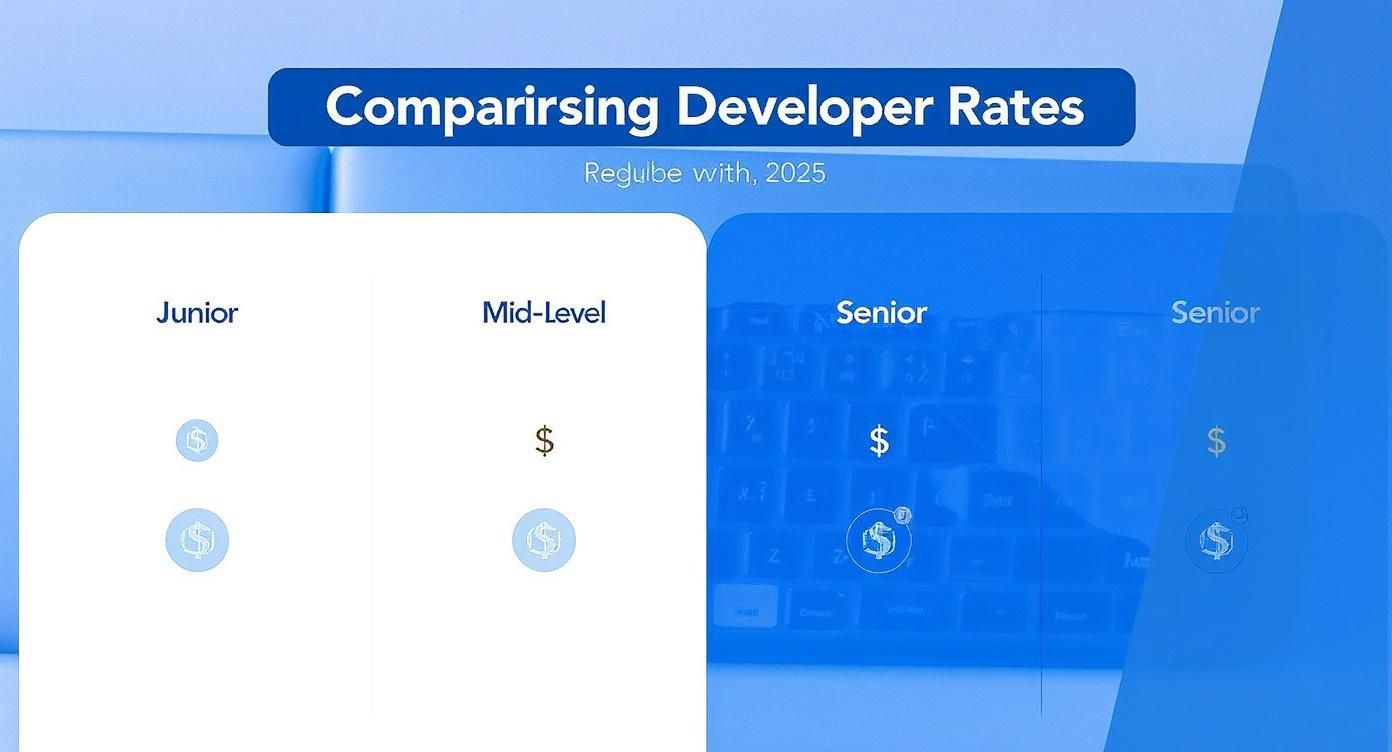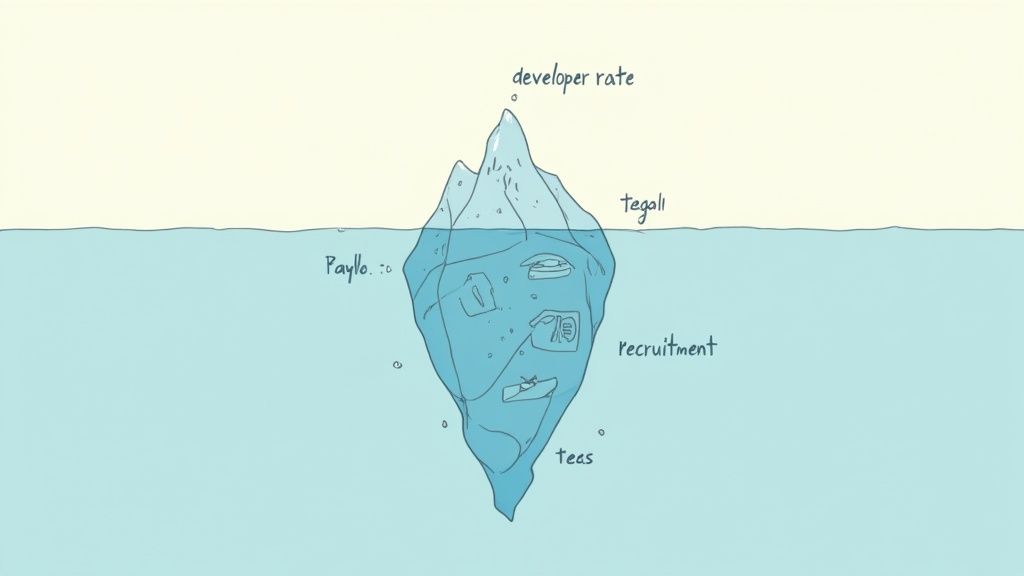Figuring out what you'll actually spend on offshore software development is about more than just looking at an hourly rate. It's a mix of a developer's skill, where they live, the complexity of what you're building, and how you choose to work with them. While you might see rates as low as $10 an hour […]

Figuring out what you'll actually spend on offshore software development is about more than just looking at an hourly rate. It's a mix of a developer's skill, where they live, the complexity of what you're building, and how you choose to work with them. While you might see rates as low as $10 an hour in Africa or as high as $85 an hour in Eastern Europe, chasing the lowest price tag is a classic mistake.
Think of it less like buying a service and more like investing in your company's future.
Smart offshoring is all about hitting that perfect balance between your budget, the quality of the work, and how fast you can get your product out the door. A lot of people fall into the trap of thinking it's just a race to the bottom on price. But the companies that really win at this treat it as a way to tap into a global talent pool, get to market quicker, and use their money more effectively.
This guide will help you make sense of all the moving parts. We’ll break down every variable so you can turn what seems like a bunch of unpredictable costs into a solid, reliable part of your business plan. The goal here isn't just to cut costs—it's to build a better product, faster.
Before we get into hard numbers, let’s look at the main things that make up your total cost. Each one affects the others, so it's important to see how they all fit together.
The chart below gives you a clear picture of how developer rates change based on seniority and location.

As you can see, a developer's seniority always plays a role in the price, but the starting point is really set by their location. A big part of these costs also comes down to logistics; figuring out the best way to pay international contractors can save you a lot of headaches and money.
To give you a clearer picture, here’s a quick summary of what you can expect to pay per hour across different regions in 2025. These are, of course, general ranges, but they provide a solid starting point for budgeting.
| Region | Junior Developer (per hour) | Mid-Level Developer (per hour) | Senior Developer (per hour) |
|---|---|---|---|
| Eastern Europe | $25 – $40 | $40 – $65 | $65 – $85+ |
| Latin America | $25 – $40 | $40 – $60 | $60 – $80+ |
| Asia | $12 – $25 | $25 – $50 | $50 – $80+ |
| Africa | $10 – $20 | $20 – $40 | $40 – $60+ |
These numbers highlight just how much rates can vary. A senior developer in Africa might cost the same as a junior or mid-level developer in Eastern Europe, which is exactly why looking beyond just the hourly rate is so critical to making a good hiring decision.

Figuring out your offshore software development costs isn't as simple as pulling a number off a menu. It’s more like pricing out a custom-built car—the engine, the materials, the person building it, and how you plan to use it all change the final sticker price.
Your total budget is a blend of several key ingredients. Once you get a feel for how each one affects the overall cost, you can make much smarter decisions, find the perfect talent for your project, and dodge those nasty budget surprises later on.
Let's unpack these drivers one by one.
The single biggest lever on developer rates is geography. Plain and simple. The cost of living and the demand for tech talent in a developer's home country have a direct impact on what you’ll pay per hour.
For instance, hiring a developer from Eastern Europe, a region famous for its top-notch technical schools, will almost always cost more than finding someone with a similar skillset in Southeast Asia. This isn't a reflection of quality—it's just economics at play. A senior developer in Poland might quote $65 per hour, while an equally talented developer in the Philippines could be closer to $45 per hour. This is the real power of a global hiring strategy: you can find that perfect sweet spot between skill and cost.
Like any craft, mastery costs more. You wouldn't hire an apprentice to frame a skyscraper, and the same logic applies here. A junior developer is perfect for well-defined, straightforward tasks. But for your trickiest challenges, a senior developer's higher rate often delivers a much better return on your investment.
Why? They write cleaner, more efficient code, solve problems in a fraction of the time, and need far less hand-holding. All of that saves you money in the long run by shortening the project timeline. Think about it: a gnarly bug could have a junior dev spinning their wheels for ten hours. A senior engineer might squash it in two. Even if their hourly rate is double, you just saved six hours of billable time and kept the project on track. The trick is matching the complexity of the work to the right level of experience.
"A common mistake is to only look at hourly rates. A lower rate may seem appealing, but if it takes longer to complete the project or the quality of the work is lower, you may end up paying more in the long run. Consider the team's experience, work quality, and communication skills."
The tools for the job matter, too. If your project uses mainstream technologies like JavaScript or PHP, you’re in luck—there are tons of skilled developers out there, which keeps rates competitive.
But if your project depends on something more niche, like a cutting-edge AI framework or an old-school legacy system like COBOL, the talent pool shrinks dramatically. With fewer experts available, the costs naturally go up. If you're still in the planning phase, knowing the cost implications of your tech choices is a huge advantage. You can find some great advice on outsourcing custom software development that can help you make these calls early on.
Finally, the way you structure the work relationship directly shapes your bills. Each model offers a different balance between cost predictability and operational flexibility.
To get the full picture, you also have to think beyond just developer rates. Smart financial planning, including optimizing offshore company setup, tax efficiency, and banking specifically for software and IT development companies, can unlock huge savings and make your entire operation run more smoothly.
Looking only at lower hourly rates is a rookie mistake. It's like buying a car based on the paint job while ignoring the engine. The real win with offshoring isn't just about saving a few bucks; it's about the Return on Investment (ROI)—how that money saved turns into fuel for growth and a genuine strategic edge.
Think about what it costs to hire a developer in a high-cost city like San Francisco or New York. The salary is just the beginning. You're also on the hook for benefits, payroll taxes, pricey office space, new equipment, and recruiter fees. This is what we call the fully-loaded cost, and it easily adds another 30-50% on top of the base salary. Suddenly, that $150,000-a-year developer is actually costing you well over $200,000.
Offshoring completely flips that math on its head. By tapping into a global talent pool, you sidestep most of that overhead. The capital you free up can be poured back into the business—into marketing campaigns, a bigger sales team, or faster product development.
The true ROI of offshoring is a mix of hard cash savings, speed, and strategic freedom. When you're running the numbers, you have to look at the whole picture.
The financial case for offshoring is pretty hard to argue with when you compare the total cost. Most analyses show that companies save an average of 52% by offshoring versus hiring locally.
When you factor in all the overhead, a US-based developer can cost between $150 and $180 per hour. Contrast that with typical offshore rates of $20 to $70 per hour. The Philippines is a great example of value, with senior developers available for $25 to $45 an hour. In Eastern Europe, you'll pay more—around $35 to $70—but you get access to incredibly advanced technical talent. Even Latin America, which is about 20-30% more expensive than hubs in Asia, offers the huge benefit of working in a similar time zone. You can dive deeper into the numbers in this offshore development cost analysis.
This strategic thinking should also include options like nearshoring, which strikes a great balance between cost savings and closer collaboration. If you’re trying to figure out which global strategy fits best, our guide on what nearshore software development is is a great place to start.
To get a quick sense of your potential ROI, think in terms of both savings and gains. First, figure out the fully-loaded annual cost for a comparable team in your home country. Then, calculate the all-in cost for your proposed offshore team. The difference is your direct savings.
ROI Calculation Example
- Domestic Team Cost (3 developers): $180,000 salary/dev + 40% overhead = $756,000/year
- Offshore Team Cost (3 developers): $60,000 salary/dev (all-inclusive) = $180,000/year
That's an annual savings of $576,000. That isn't just money saved; it's capital that can be reinvested to accelerate growth. You’ve just turned a cost center into a strategic asset that can multiply its own value. This is how you stop thinking about just cutting your offshore software development costs and start thinking about amplifying your entire business.
Hourly rates are one thing, but what does it all look like when the rubber meets the road? Seeing how offshore software development costs come together in a real-world project is the best way to get a feel for your own budget.
Let's walk through three common scenarios to make these numbers tangible. We'll base our estimates on a team in a mid-cost region like Latin America, where a blended team rate often lands between $40 and $65 per hour. This sweet spot gives you a great balance of top-tier talent, reasonable costs, and convenient time zones.
You're a startup founder with a game-changing app idea. The mission? Get a Minimum Viable Product (MVP) built to test the market, wow your first users, and maybe even get some investors on board. You don't need all the bells and whistles—just the core features, done well, and done fast.
You've set an aggressive three-month timeline. To pull this off, you need a lean, agile team that can hit the ground running.
A smart MVP team setup would probably include:
This structure gives you all the essential skills without any extra fluff. The entire focus is on speed and execution.
Here's a sample budget to give you an idea of what that three-month sprint might cost.
| Role | Team Members | Est. Monthly Cost (USD) | Total Project Cost (USD) |
|---|---|---|---|
| Project Manager (Part-Time) | 1 | $3,500 | $10,500 |
| UI/UX Designer | 1 | $7,500 | $22,500 |
| Software Developer | 2 | $16,000 ($8,000 each) | $48,000 |
| Total | 4 | $27,000 | $81,000 |
For around $81,000, you could get your product off the ground with a solid, experienced offshore team—a realistic launchpad for any new venture.
Okay, fast forward a bit. Your MVP was a hit! You've got users, you're making money, and you have a roadmap packed with new features. It's time to shift gears from a one-off project to a long-term strategy. You need a stable, dedicated team that lives and breathes your product.
This is where you bring in a dedicated team on a monthly retainer. They'll handle all the new feature development, ongoing maintenance, and bug squashing. The beauty of this model is the stability—no more ramping up new people. You get a team that's in it for the long haul.
Your new dedicated team might look like this:
The biggest win with a dedicated team is predictability. You lock in a fixed monthly cost for a crew that is 100% focused on your business, which makes long-term financial planning so much easier.
Your monthly cost depends heavily on the team's location and skill set. If you're weighing your options, diving into the best countries to hire remote developers in 2025 can give you a much clearer picture of how geography affects your budget.
Now for the big leagues. Imagine a large company that needs a sophisticated internal platform. We're not talking about a simple app—this is a beast of a system that needs to talk to old legacy software, pass tough security audits, and crunch huge amounts of data. This kind of project demands specialized skills and a much bigger, more structured team.
The timeline is longer, maybe six to nine months, and the tech stack is advanced, possibly involving things like cloud architecture, data science, or even machine learning. Naturally, the offshore software development costs will be on a different scale.
A team for an enterprise build-out could easily include:
For a team with this much firepower, you could be looking at a monthly burn rate of $80,000 to $120,000 or more. The total project cost could easily fall between $480,000 and over $1,000,000. It's a serious investment, but it's often just a fraction of what it would cost to assemble a team with the same expertise on home turf.

The hourly rate you see on a proposal? That’s just the starting point. The real offshore software development costs are often buried in a layer of expenses that many companies don't see coming until the invoices start rolling in. These aren't just minor rounding errors, either; they can seriously inflate your budget if you're not prepared.
Think of it like buying a house. The sticker price is what gets your attention, but you still have to account for closing costs, property taxes, insurance, and unexpected repairs. It's the same deal when hiring offshore talent—the developer's rate is just one piece of a much larger financial puzzle.
It's these hidden expenses that can turn a seemingly great deal into a financial headache. Getting a clear picture of them upfront is the only way to build a budget that holds up in the real world.
Beyond a developer's direct compensation, a whole host of operational costs can pile up fast. Let's be honest, these are the necessary evils of managing an effective remote, international team.
Here are some of the usual suspects that often get missed:
Now, this is the big one—the most complex and potentially costly area of all. Trying to navigate international labor laws, payroll taxes, and benefits administration is a minefield. Every country has its own specific rulebook for paid time off, mandatory social contributions, termination protocols, and more.
Get it wrong, and you could be facing steep fines and legal nightmares. You’re not just hiring a freelancer; you’re engaging with another country’s entire legal and financial framework.
The true value of a strategic partner isn't just finding you a developer. It's about transforming this entire mess of unpredictable compliance and administrative costs into a single, predictable monthly invoice.
This is where a managed service provider becomes a game-changer. Partners like HireDevelopers.com take on the entire burden of international payroll, benefits, and local labor law compliance. It completely de-risks the process for your business. Instead of having to become an overnight expert in foreign tax law, you can put 100% of your focus on building your product.
This approach turns a dozen potential budget-breakers into one simple, all-inclusive line item. No more nasty surprises when the bills come due.
After digging into all the variables—from regional rates to those sneaky compliance fees—it's obvious that managing offshore development costs is more than just chasing the lowest hourly rate. The smartest play isn't to micromanage every line item. It's about finding a partner who turns a logistical nightmare into a simple, predictable investment. That’s where the real value kicks in.
A strategic partner completely changes how you think about your budget. Forget spending weeks and thousands of dollars on recruitment. You get immediate access to a pool of talent that’s already been put through the wringer. Platforms like HireDevelopers.com handle all the heavy lifting—from AI-powered résumé filtering to rigorous technical interviews—so you only talk to the top 1% of developers. This completely wipes out your recruitment costs and shrinks your time-to-hire from months to days.
Honestly, the biggest weight off your shoulders is ditching the administrative and legal grunt work. A managed partner takes on the entire headache of international payroll, benefits, local tax laws, and tricky labor compliance. All those hidden costs and potential legal landmines we talked about? They just vanish.
Instead, you get a single, transparent monthly invoice. This approach gives you incredible budget predictability. You know exactly what you’ll spend each month, which frees you up to focus on what you’re actually good at: building a great product, not becoming an expert in foreign employment law.
The global talent market is a big place, and rates are all over the map depending on the firm and where they’re located. Mid-market agencies might bill anywhere from $120 to $250 per hour, while typical offshore firms fall in the $27 to $82 per hour range. For a deeper dive, this 2025 software development price guide offers some great insights. A real partner helps you cut through the noise to find the best value, not just the rock-bottom price.
Ultimately, the right partner isn't just selling you developer hours. They're providing a complete operational solution that de-risks your project, locks in your budget, and makes sure your offshoring strategy actually delivers a solid return.
This simplified model lets you tap into global talent without all the usual friction. By getting the operational junk out of the way, a partner ensures your money is spent on what actually matters—building fantastic software that pushes your business forward. It’s what turns offshoring from a simple cost-cutting move into a powerful engine for growth.
Jumping into the world of global talent can feel like navigating a maze. Let's clear things up with straightforward answers to the questions I hear most often about offshore software development costs.
There's a persistent myth that you need a massive, six-figure budget to even think about going offshore. That's just not true. For building a Minimum Viable Product (MVP), a realistic starting point is usually in the $25,000 to $50,000 range.
What does that get you? Typically, it covers a 2-4 month project with a small, laser-focused team—maybe one or two developers and a part-time project manager. It’s enough runway to build the core of your app, validate your main business idea, and start getting that all-important feedback from real users. The trick is to be ruthless with your priorities; focus only on what's essential to get the most bang for your buck.
You can find brilliant developers anywhere, but some regions have naturally become hubs for certain kinds of tech. Think of this less as a strict rule and more as a helpful starting point in your search for niche skills.
Going for a more budget-friendly region absolutely does not mean you have to compromise on quality. The secret sauce is a bulletproof vetting process. You can't just pick the lowest hourly rate and cross your fingers.
Honestly, the most reliable approach is to lean on a partner that does the heavy lifting for you. Platforms that pre-screen their talent take all the guesswork out of the equation. They're already running technical challenges, digging through portfolios, and checking for communication skills. This means that even in a lower-cost market, you get access to professionals who are at the top of their game.
A partner’s vetting process is your first line of defense against poor quality. By filtering for the top 1% of talent, they ensure that lower offshore software development costs don't translate to a lower-quality product.
People often use these terms interchangeably, but they describe two different things. Nailing the distinction helps you communicate exactly what you need.
Outsourcing is all about who does the work. It’s simply the act of hiring an outside company or person to handle tasks that you used to do internally. Their location doesn't matter.
Offshoring, on the other hand, is about where the work gets done. It specifically means having work performed in another country, usually to tap into lower labor costs or a bigger pool of specialized talent. You can offshore work to your own company branch abroad, or you can offshore it by outsourcing to a company in another country.
Navigating the technical interview for an Azure role requires more than just reciting definitions; it demands a demonstration of practical, scenario-based knowledge. The cloud computing market is intensely competitive, and understanding the nuances of Microsoft's platform is critical. For those deciding on a cloud specialty, a detailed AWS vs Azure vs GCP comparison can clarify […]

TypeScript has become a core competency for modern software development. As its adoption skyrockets, so does the demand for engineers who can wield its type system with precision and strategic foresight. Demonstrating this expertise under interview pressure, however, presents a unique challenge that goes beyond recalling basic syntax. This guide moves past simple Q&A lists […]

For a long time, the software world got developer productivity all wrong. We measured what was easy to see, not what actually mattered. Redefining Developer Productivity Beyond Code Ask any old-school manager how they measured a developer's output, and you'd likely hear about lines of code, the number of commits, or how many tickets they […]
